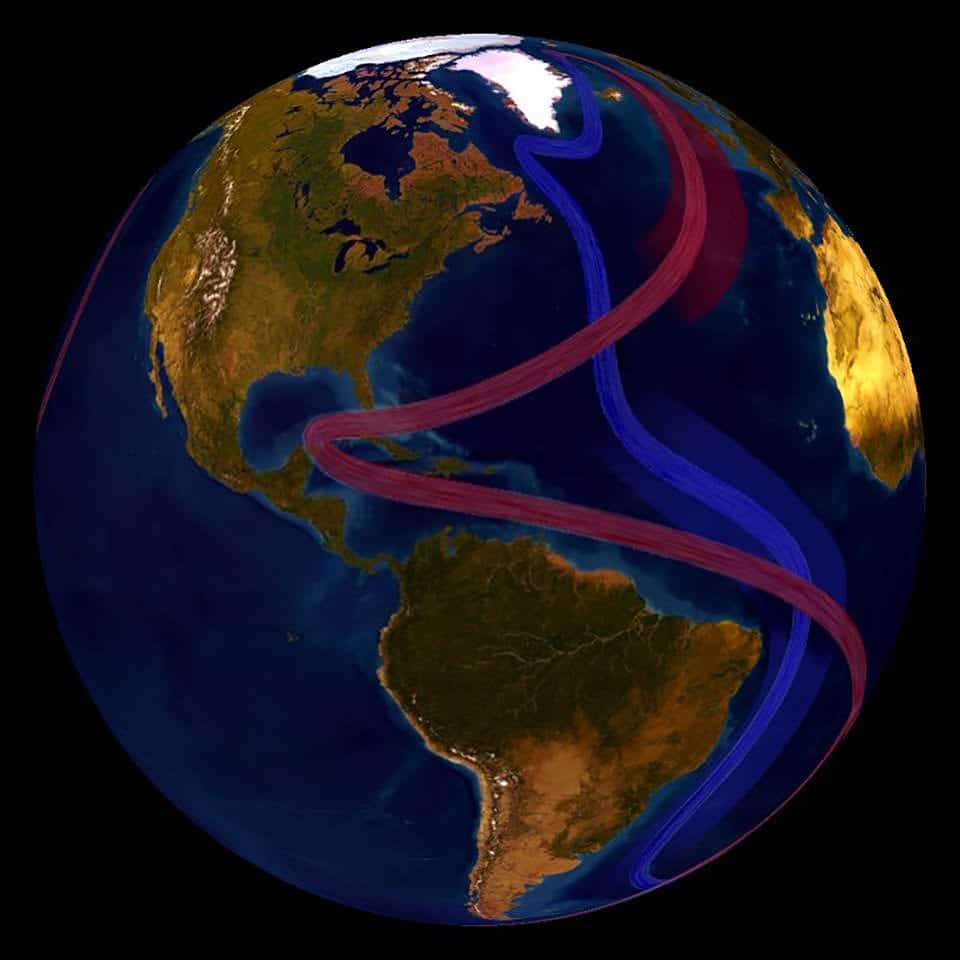A system of ocean currents that influences weather patterns across the northern hemisphere could shut down sooner than expected because of climate change. By 2050, the Atlantic meridional overturning circulation (AMOC) may reach a tipping point, a new study concludes — though not everyone is convinced.

AMOC is a system of ocean currents that acts like a conveyor belt. It circulates water from north to south and then back in a cycle within the Atlantic Ocean. AMOC is part of a global circulation system in the oceans and is integrated into both surface and deep currents in the Atlantic Ocean. This ensures a constant mixing of the Earth’s oceans, facilitating the distribution of heat and energy across the globe. Consequently, it significantly influences the world’s climate patterns.
But it goes both ways. Just like these currents can affect climate, climate can also affect the currents.
Scientists have been warning that climate change is weakening the AMOC, potentially leading to its collapse in the future. The last time it shut down was at the end of the last ice age 14,500 years ago. Glacial melt flooded the North Atlantic with fresh water, which caused the system to collapse, leading to temperatures in Europe to plunge.
However, since the AMOC has only been monitored since 2004, researchers haven’t been able to make clear estimates of when a new collapse could happen.
Now, a study used sea surface temperature data dating back to 1870. This offers indirect, proxy information regarding the stability of the AMOC. The study suggests that a collapse could happen in the middle of this century.
“Shutting down the AMOC can have very serious consequences for Earth’s climate,” Peter Ditlevsen, study author, said in a statement. “While a cooling of Europe may seem less severe as the globe as a whole becomes warmer and heat waves occur more frequently, this shutdown will contribute to increased warming of the tropics.”
A collapse of the AMOC

AMOC’s collapse is one of the tipping points for Earth that are threatened by global warming.
Studies published over the past five years found the AMOC collapse was possible, but researchers stopped short of making a precise estimate. Now, Ditlevsen and his team were able to address this by using sea surface temperature data from the sub-polar North Atlantic.
Their study even goes further than the United Nation’s Intergovernmental Panel of Climate Change (IPCC), a leading group of climate scientists, which agreed AMOC is weakening but dismissed a full collapse in the 21st century. Ditlevsen said the IPCC’s models were conservative and didn’t consider AMOC’s recent early warning signals.
“We’ve made calculations that provide a more robust estimate of when a collapse of AMOC is most likely to occur, something we had not been able to do before,” Susanne Ditlevsen, study author said. The researchers suggest a collapse is possible at any time between 2024 and 2180. Specifically, the 2025-2095 period is when this is more likely.
A collapse of AMOC would produce marked cooling across the northern hemisphere, triggering stormier winters and drier summers in Europe. Simultaneously, heat would intensify in the southern hemisphere, as less warmth is transferred to temperate and polar altitudes. There would then be big changes in tropical rainfalls and monsoons.
How bad is it?
Several researchers reacted to this study. Richard Pancost, Professor of Earth Systems at the University of Bristol Cabot, emphasized the importance of climate tipping points.
Climate change tipping points refer to thresholds in the Earth’s climate system that, when crossed, can lead to significant and often irreversible changes. These changes can be abrupt, happening over a span of years to decades, as opposed to the slow, gradual changes we’re often used to when thinking about climate change. They’re called “tipping points” because they can be likened to a seesaw or balance that, once tipped to one side, cannot easily return to its original position.
An AMOC collapse could be such a tipping point, Pancost cautions.
“A change in ocean circulation has long been considered to be a critical climate change induced tipping point. This paper provides evidence that our carbon emissions have pushed us towards this tipping point. What is particularly important about this paper is how it highlights the non-linear responses to climate change – we are not sure what degree of warming will cause key aspects of the Earth system to change. This is further illustrated if we consider how this change in ocean circulation will have impacts on other parts of the Earth system. How will it affect the climate of different Atlantic regions? How will it affect Arctic or deep sea ecology? As we continue to burn fossil fuels, we risk crossing a variety of thresholds for both our climate and nature – potentially irreversibly.”
However, Andrew Watson from the University of Exeter also mentions that the instability of AMOC could be less dramatic, suggesting a change in sites of deep-water formation instead of a full shutdown. “Most models suggest a slowing and not a shutdown during this century,” Watson said.
Penny Holliday, Head of Marine Physics and Ocean Circulation at the National Oceanography Centre, the validity of sea surface temperature data from the sub-polar North Atlantic as a proxy is still a matter of scientific debate. Holliday also said the study “overstates the likelihood” of the AMOC collapsing within the next few years and mentions that other studies had different findings.
So we’re not really sure just how bad it is, but this doesn’t mean we shouldn’t act to tackle climate change. The one thing that is clear is that climate change is having an effect on us now, and the potential collapse of AMOC further underscores the importance and urgency of mitigating our impact. It serves as a sobering reminder that our actions today are shaping the world of tomorrow – and the time to act decisively is now.
The study was published in the journal Nature Communications.



